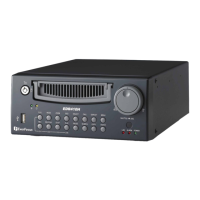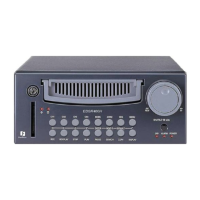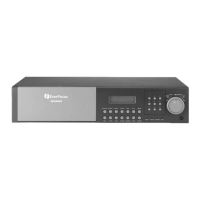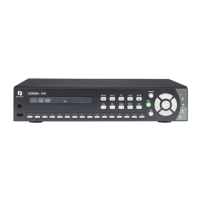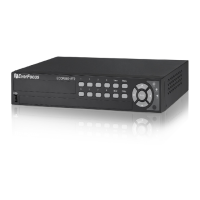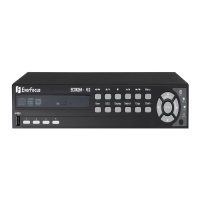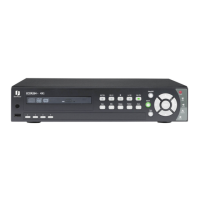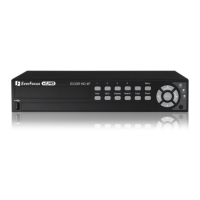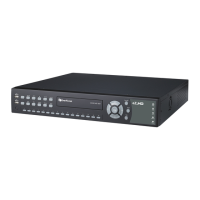Do you have a question about the EverFocus EDVR SERIES and is the answer not in the manual?
Lists the key features of the DVR, including Pentaplex operation and connectivity options.
Details technical specifications like video format, input/output, compression, and resolution.
Describes the function of each button on the DVR's front panel for operation.
Identifies and explains the purpose of various ports on the DVR's rear panel.
Explains status information and event signs shown on the DVR's screen.
Lists the contents found in the product packaging upon delivery.
Illustrates typical diagrams for connecting the DVR system components.
Guides through connecting power, cameras, monitors, and network interfaces.
Outlines the steps to power on the DVR after installation.
Configures system time, date format, and daylight saving settings.
Sets camera titles, PTZ IDs, recording quality, and motion detection parameters.
Configures audio recording, time stamps, watermarks, and resolution.
Manages alarm detection, types, duration, and output signals.
Configures motion detection sensitivity, area, and triggered actions.
Sets up video loss detection, duration, and alarm notifications.
Configures IP settings, network services, email alerts, and DDNS.
Configures IP address, subnet mask, gateway, and DNS server settings.
Sets up alarm notifications to an alarm server via network protocols.
Configures SMTP server details for sending email alerts on events.
Manages user-level access and passwords for network login.
Configures DSL connection parameters including username and password.
Sets up dynamic DNS service for remote access with dynamic IP addresses.
Configures timed recording schedules by day, start, and end times.
Provides information on disk status and options for disk formatting.
Configures serial communication settings (RS232/RS485) and PTZ protocols.
Configures system warnings for fan failure, HDD issues, and full drives.
Manually starts recording by pressing the record button.
Sets up recording based on pre-defined time periods.
Configures recording triggered by alarms or motion events.
Explains how to play back recorded video and audio using the PLAY key.
Details searching recorded events by time, date, or event type.
Instructions on how to download and view archived video files.
Configures the call monitor display, sequence mode, and OSD status.
Switches between different display modes like 4, 9, 10, 13, 16 channel, and PIP.
Explains basic networking concepts like IP addresses and their structure.
Details the function and format of subnet masks for network identification.
Explains the role of gateway addresses in routing network traffic.
Describes network ports and their use in accessing applications.
Questions to consider regarding internet connection before setup.
Outlines different types of network connections for DVR setup.
Instructions for direct DVR to computer connection using a crossover cable.
Steps for connecting the DVR via a modem directly to the network.
Details for connecting the DVR via a router or existing LAN.
Guides through the process of setting up a DDNS account for remote access.
Instructions for searching recorded events by time or event type via web browser.
How to control PTZ cameras remotely via web browser interface.
Steps for archiving video files remotely from the DVR.
Checks for HDD lock and Cable Select settings for recording issues.
Verifies proper wiring and power supply for display issues.
Isolates issues between camera and DVR ports for channel display problems.
Checks ISP port blocking, IP address, and router port forwarding for connectivity.
| Video Input | 4 / 8 / 16 channels |
|---|---|
| Audio Output | 1 channel |
| Mobile Viewing | Yes |
| Operating System | Embedded Linux |
| Video Compression | H.264 |
| Mobile Support | iOS, Android |
| Video Output | VGA, HDMI |
| Recording Resolution | Up to 1080P (depending on the model) |
| Recording Frame Rate | Up to 30fps per channel |
| Audio Input | 4 channels (depending on the model) |
| Hard Drive Bays | 1 / 2 |
| Network Interface | 10/100 Mbps Ethernet |
| Hard Drive Capacity | Up to 6TB |
| Remote Viewing | Yes |
| Power Supply | DC 12V |
